By the time Resident Evil 7 reared its beautiful, ugly head in 2017, I was already fairly well acquainted with the survival horror genre. It just so happened to work out that the time I started getting really into gaming was the same timeframe that I first started getting into horror as well, so horror and horror adjacent games were naturally some of the first ones I decided to explore.
Some of my earliest experiences with games were within the survival horror genre—or at the very least, comfortably adjacent to it. Left 4 Dead, Bioshock, Dead Space, Outlast…these were some of my earliest and most formative excursions into not just the survival horror genre, but gaming as a whole. In one particularly memorable personal story, the first and only time I seriously got into game modding was when I and an old online buddy spent the better part of a summer trying a witch’s brew of patches and source code modifications to get System Shock 2 up and running on a modern PC—only for the game to drop in full working order on Steam about three weeks after we finally got the damn thing running with sound.
So, by the time 2017 rolled around I was no stranger to survival horror, nor was I a stranger to the Resident Evil franchise as a whole. I’d already chewed my way through the great Resident Evil 4, then eagerly booted up Resident Evil 5 ready for more thrills and…look, all you really need to know about Resident Evil 5 is that it’s a game so thoroughly neglected, as of this writing, the version that is sold on Steam does. not. work. When you try and run it, it attempts to redirect you to Games for Windows Live, a service that has not existed since 2014. You need to download a third-party patch just to run the game you have legally bought and paid for, which is both absurd and hilarious. Then there’s Resident Evil 6, a game that I have not played and that every piece of information I have tells me I should not play—although to my knowledge, the version on Steam at the very least runs without needing a third-party patch, so I guess that’s a point in their column.
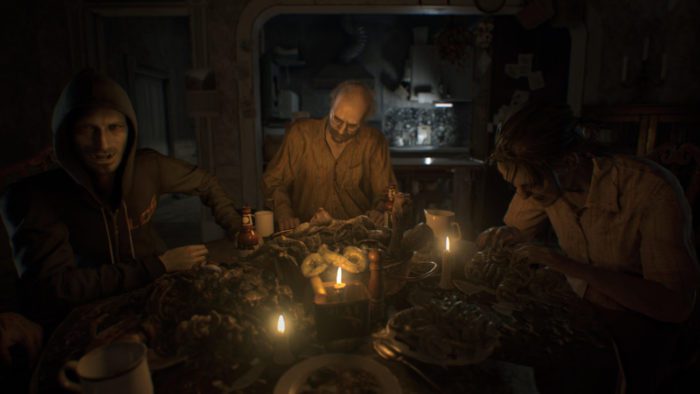
The point is, it’s a well-known fact by now that by that point in time, Resident Evil had long since lost its way. The franchise had leaned far too hard into the action elements of 4, and by the time 6 shambled around the franchise was starting to feel like one of its own monsters—and not in a good way, but in the “shambling, grotesque pile of incoherent flesh that is almost unrecognizable from what it once was” sort of way. Between the disaster that was Resident Evil 6 and the now legendary non-existence of Silent Hills—a Silent Hill title that was supposed to star Norman Reedus and be a creative collaboration between none less than Hideo Kojima, Guillermo Del Toro, and Junji Ito—it’s safe to say that there was very real concern that both the giants of survival horror might have gone the way of the dinosaur.
Then, at E3 2016, came the game’s first announcement, as well as a teaser trailer that was such a drastic departure from the likes of 5 and 6 that people didn’t know it was even Resident Evil until the title was revealed at the very end. For the first time in years, there was real, tangible excitement about the future of Resident Evil, and thankfully that excitement was more than warranted: Resident Evil 7 wasn’t just a return to form for the franchise, nor was it simply just an excellent piece of survival horror—for my money, it’s the closest thing we’ll ever see to a perfect survival horror game.
What’s Old Is New Again
At first glance, Resident Evil 7, subtitled Biohazard is virtually unrecognizable from the games that immediately preceded it—fun fact, in Japan, the franchise is known as Biohazard, so the game’s full title there is Biohazard 7: Resident Evil. The most obvious change, of course, was the shift from a third-person perspective to a first-person one that gave the game a brand new sense of total immersion, but even that’s only scratching the surface. Resident Evil 7 at its very core is a stripped-down, back to basics approach that feels closer to the original Resident Evil than anything from the post 4 era. Suddenly, we’re back to the beginning of exploring every corner of a spooky old mansion, without a quick time event or punchable boulder in sight.
Even our new protagonist reflects this new, more grounded approach, whereas Resident Evil games in the past had starred over-the-top Big Damn Hero types—the Chris Redfields and Leon S. Kennedys of the world—but here we get Ethan Winters, a twenty-something white dude with zero combat experience and whose main defining trait is how absolutely goddamn much he does not want to be here. Previous games had featured overarching narratives of “save the President’s daughter!” and “investigate this outbreak of zombie virus in Africa!” and “EVERYTHING IS ZOMBIES AT THE SAME TIME SO WE NEED TO THROW THREE NARRATIVES AT YOU LOOK AT HOW BIG AND AMBITIOUS THIS GAME IS!” Ethan’s objective? Rescue his wife when he gets a cryptic message from her after she had been missing for three years (he hadn’t moved on either, my boy remains loyal.)
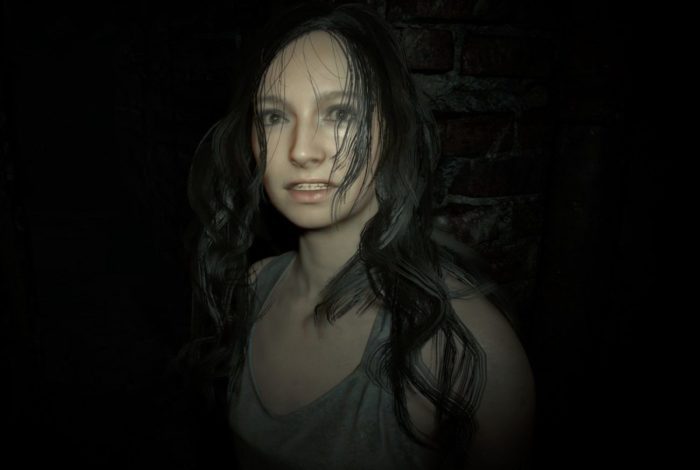
But it wasn’t simply about going back to the basics, but also drawing inspiration from more modern horror titles like Amnesia or Outlast. It’s a similar approach to one of the last titles you might think of in a discussion about Resident Evil 7—The Legend of Zelda: Breath of the Wild. That game, just like Resident Evil 7, was an almost complete reimagining of what the franchise was and could be, deciding what the fundamental core elements were and throwing out everything else while simultaneously taking inspiration from what newer studios were doing with that particular genre, usually ones who had been inspired by them in the first place…or to think about it another way, an old master showing the young guns how it’s done (while also taking a lesson or two from them.) Another similarity the two games share is a refreshingly simple approach to objectives: Resident Evil 7‘s objectives usually don’t go into any more detail beyond “get out of the house” or “get the shotgun”—anything beyond that, it’s up to you to figure out.
The core of what makes Resident Evil 7 so damn scary is an absolutely pitch-perfect sense of pacing and escalation. From the opening hour in the guest house to the way in which the main house slowly unfolds as you explore further and further, it’s a masterclass in both environment building and in managing tension. But it isn’t just full-on horror, the mansion is also filled with very human touches and relics from happier times: a portrait of the Baker family, a football helmet that Jack once used, Lucas’ science fair trophies, or Jack and Marguerite’s fairly ordinary-looking bedroom. It certainly doesn’t make the Bakers any less terrifying, but it does add depth and a real sense of tragedy that elevates them beyond simply being cardboard cutouts—they’re ultimately victims in all this, just as you are.
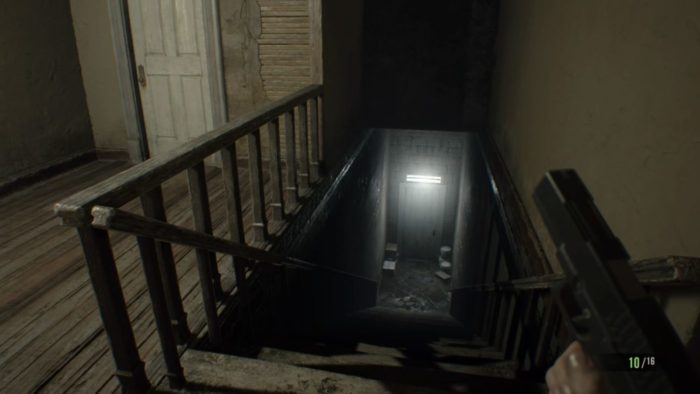
But as I said, it doesn’t make them—or the game—any less horrifying. Resident Evil 7‘s brilliance lies in a tight, relentless gameplay loop that it sends you through over and over again: first, you get thrown into some terrifying, edge of your seat situation straight out of a nightmare; then, you barely escape said terrifying situation and get some breathing room to further explore the mansion and its grounds to really take in the environment; then you get a glimpse of the next place you have to go and realize “Oh god, I’m about to walk straight into something much, much worse.” Every closed door becomes a point of anxiety, knowing that something out of your nightmares is waiting just behind it—and that at some point, you’re going to have to open that door, whether you like it or not. The first hour or so in the main house was spent almost entirely on the edge of my seat, trying to escape Jack as he relentlessly hunted me throughout the rooms and hallways—and then when I finally escaped into the back section and walked past the grimy stairs going down to the basement, I suddenly would have given anything to stay on the main floor with Jack and not figure out what was waiting for me down below.
Know Your History
This sense of escalation goes hand in hand with one of the coolest things about Resident Evil 7 that I rarely see talked about: the Baker family—specifically the fact that the order you encounter them is actually a history lesson in American horror cinema. First, there’s Jack, a slasher villain straight out of the ’70s. He stalks you relentlessly throughout the first section of the house, reappearing just when you think you’ve given him the slip in increasingly grotesque forms—and with increasingly absurd weaponry. It’s a relentless game of cat-and-mouse that even feels like one that’s an offspring of the two granddaddies of the slasher genre’s formative years: Halloween and The Texas Chain Saw Massacre.
The upper floors capture Halloween‘s sense of domestic invasion—it might not be your house, but it is a house, one that feels under assault from “crazy guy with a weapon.” You hide in the kitchen and dining room while holding your breath in the hopes that Jack will pass you by, you scurry up and down the stairs in the main hall to try and shake him in your search for the key to the back door of the house, and you scamper beneath the floorboards in a desperate attempt to find some level of safety.
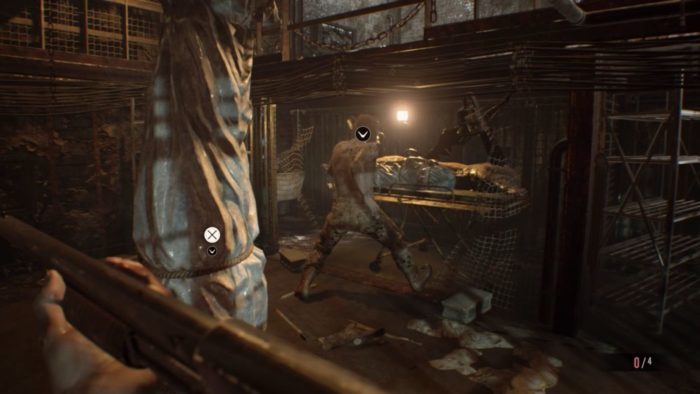
The downstairs, on the other hand, is full-on Texas Chainsaw, a grimy, grisly maze full of Molded, incinerators filled with bodies, even a room with a relentlessly humming generator reminiscent of the one that became a central piece of Chainsaw‘s iconic sound design. I’ve already mentioned it, but even before you get there, walking past the staircase to the basement and the sickening glow of its fluorescent light fills you with dread—by now you’ve spent at least a good hour with Jack on the upper floors, so even just knowing that one of the rooms down there is called the “dissection room” makes your stomach churn as your mind tries to figure out how gruesome things will be when you inevitably get there. It even ends with a completely over-the-top, ridiculous, kick-ass chainsaw duel that feels like the iconic chainsaw duel in Mandy by way of The Texas Chainsaw Massacre 2, one where you literally throw Jack off balance by kicking hanging bodies into him—but we’ll get into more on that later.
Next up, there’s Marguerite, embodying the ’80s. Her encounter starts similarly to Jack’s—after all, the slashers were still going strong in the ’80s—but with a couple of key differences. First off, there’s a significant change in environment. The main house of the Baker estate, run down as it may be, still feels like a home—or at least, that there’s one hiding beneath the layers of grime and goo. The old house where you encounter Marguerite, on the other hand, has a tangible sense of abandonment, as though it were sinking into the swamp beneath your feet. It feels like one of the old cabins you might find in one of the ever-popular campsite slashers of that timeframe, think Madman or Friday the 13th.
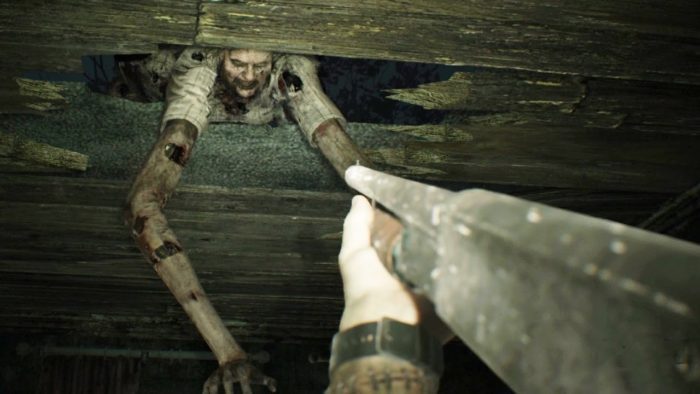
Secondly, while the old house may feel like Friday the 13th, Marguerite is no Jason. So, while she does stalk you throughout the old house, your bigger challenge is having to creep past the oversized nests of bugs that relentlessly swarm you—and all the while, she’s slowly morphing into her true form. When you finally confront her in the greenhouse, she’s gone full-on grotesque spider monster, and we finally uncover what the true inspiration for her is: body horror, the likes of which emerged in the ’80s with films like The Fly and The Thing.
In the attic of the old house, we get a brief encounter with Evelyn, surrogate daughter of the Baker family, and more importantly for this section she’s the creepy little dark-haired girl archetype synonymous with the legendary Ringu and the ’90s era explosion of J-horror. This section is over fairly quickly, and it’s mostly Molded—the gooey, humanoid monsters you encounter alongside the Baker family—that you’re fighting, but it’s still important to make note of.
Last, but not least, there’s Lucas. Lucas is a modern, 2000s style villain—basically, Saw‘s Jigsaw if he was a twenty-something jackass. His section is a giant maze of traps and puzzles and boxes that explode when you open them, all the while he’s constantly taunting you over an intercom or from behind the safety of a TV screen while never once confronting you directly. His section culminates in the diabolical “Happy Birthday” escape room-style puzzle, one of several moments where Resident Evil 7 makes use of videotapes to help you solve certain puzzles or get a sense of where a key item might be hiding.
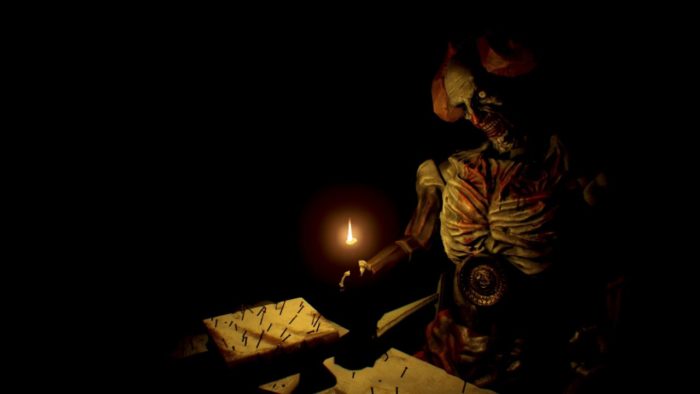
The way you solve “Happy Birthday” is one of the cleverest pieces of game design I’ve seen in years. You actually do the puzzle twice: once in a videotape, which reveals that the puzzle by its design is going to kill you even when you solve it, then a second time as Ethan—only now, you know the password for the lock from when you did it in the videotape, meaning you can avoid taking out the key that would fill the room with gas meant to ignite when you light the candle on the birthday cake and actually escape the room.
Alongside this sense of escalation and progression is the second recurring constant throughout the gameplay: the push and pull between empowering you and knocking you back down—in most cases, with one coming right after the other. The shotgun is quite literally held out for you in the hands of an old Civil War-style bust, seemingly offering an early upgrade to try and hold off Jack—but when you pick it up, the door closes behind you until you put it back. You can look at it longingly, but it’s out of your reach until you figure out the trick to getting it. An encounter with an investigating police officer gives you your first weapon and what feels like a chance at escape, only for him to meet a brutal end no more than five minutes later in the garage—your hopes of escape going up in flames along with your vehicle.
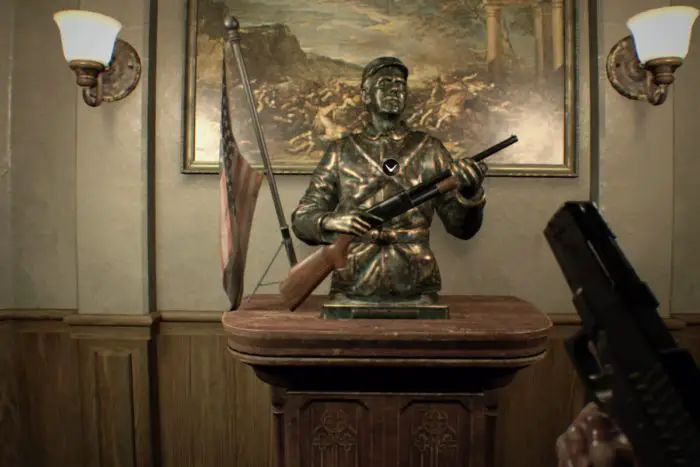
But, nowhere is this better realized than in the final fight of the first section with Jack. After first going at it with your normal assortment of weapons, Jack finally gets fed up, pulls back a section of fencing, and pulls out a bizarre chainsaw-shears combination weapon—and stuck in the same mass of flesh is a grimy chainsaw with your name on it. You dodge his attack and scamper over to where the chainsaw is—no tricks this time, you just pull it out and rev it up, with Jack even sneering out “groovy” a la Bruce Campbell—a callback to another big inspiration for Resident Evil 7, 1981’s The Evil Dead. Finally, you have something in your hands that makes you feel like you can stand up to Jack after what feels like hours of running for your life and hiding as best as you can, and tearing up Jack with the chainsaw feels exhilarating in a way that’s hard to describe. When he finally disintegrates into a gooey puddle, it’s the first real moment of triumph in the game—and one that gets you excited to tear up some Molded throughout the rest of the game.
And then, you look around the room. There’s only one way out, through a door that is shut with a heavy bar securing it in place. You search around, trying to find a key or any other way out, but it only takes about a moment to figure it out. You gulp, approach the door, hit the prompt, and Ethan starts taking that chainsaw to the bar. The bar gives in less than half a minute, but just as you feared, it takes half the chainsaw blade with it, reducing your big, flesh-ripping Excalibur of vengeance into useless scrap metal. You get the last key that you need to leave the main house but are left with only your now impotent feeling pistol and knife as the only things to help you get past the increasing number of Molded standing between you and the relative safety of the upstairs floors, immediately knocking you back down to earth from the high of finishing off Jack.
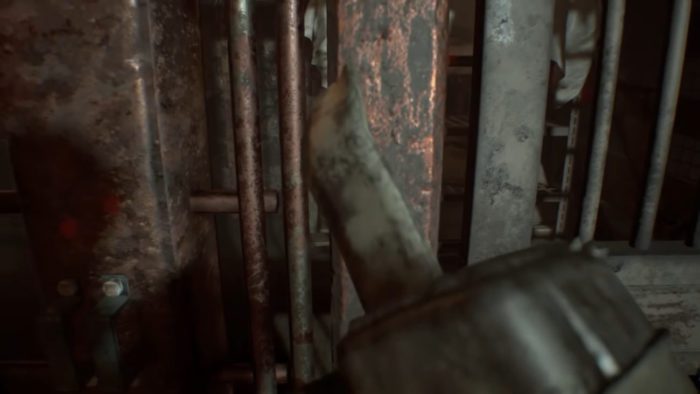
There’s a lot of smaller bits that add up, most of which were covered here previously, but I’ve already gotten a little long-winded, so let’s just say that the overall idea is this: Resident Evil 7, at least during the time you spend in the Baker estate, is a game where everything—gameplay, sound design, environment design, characters—just works, each segment fitting together perfectly into one big, grimy, beautiful house of horrors.
The Almost
Unfortunately, this article is, as the title says, about how Resident Evil 7 is almost the perfect survival horror, and it’s a pretty damn big almost. You probably already know it by now, but yes…we have to talk about the abandoned ship and the mines.
Resident Evil 7‘s final hours are one of the most jarring shifts in tone I’ve seen in any video game. We go from the fully realized Baker mansion to a fairly generic feeling abandoned ship and an even more generic mine. We go from a carefully thought out assortment of empowering but not overpowering weapons that leave you just barely able to survive to “here have a machine gun and lots of ammo go have fun, champ.” We go from not knowing what’s going on or how it connects to any other Resident Evil game to “here’s how everything actually connects to the bigger picture including how your wife was actually a super cool gun-wielding Umbrella operative.” It’s one of the worst final acts I’ve played in any game and one that feels completely out of place from the rest of the game that preceded it.
Now, I have a theory as to what happened—and for what it’s worth, I think it’s a pretty good one—but it should be noted in big, bold capital letters: THIS IS STRICTLY THEORY, I DO NOT POSSESS ANY ADDITIONAL INFORMATION THAT ISN’T KNOWN TO THE PUBLIC.
To explain my educated guess, we have to take a look at how out of place this final section feels. Firstly, these last two sections feel like the start of a different game: to start, there’s a choice you get after defeating Jack: whether to give the last dose of serum to Mia or Zoe. This makes absolutely zero sense, given that Ethan’s goal since the very beginning of the game has been to rescue Mia, and the game itself seems to acknowledge that this “choice” is ridiculous. Choose Mia, and she’s cured, the two of you attempt to escape in a motorboat, only for the boat to be attacked by Mold and you wake up from Mia’s perspective at the abandoned ship.

Choose Zoe, on the other hand, and the two of you attempt to escape on the boat same as before—but when you get to the abandoned ship Evie calcifies Zoe’s body during the boat attack so you don’t even save her anyways…and then you still wake up from Mia’s perspective at the abandoned ship. So not only is there clearly only one choice that you’re supposed to make, the choice itself has basically zero impact on the game apart from one last fight with Mia and whether or not she’s dead when the game ends—which of course is undercut by Mia being alive and well for Resident Evil Village.
Oh yeah—the section on the abandoned ship is from Mia’s perspective, and when you start the section, you have none of the weapons that you had been gathering over the previous seven or so hours of gameplay. When you do finally get a weapon it’s a fairly powerful machine gun that clashes with the slower, survival-horror tone. It all adds up to a conclusion that feels…tacked on, as though it were something added at the last minute to an already complete whole.
Secondly, it also makes sense from a narrative standpoint—both for Ethan and the player themselves—to have the game end when we leave the Baker estate. Once we leave the Baker estate with Mia finally cured, Ethan’s story is, for all intents and purposes, over: he’s accomplished what he set out to do by finding and rescuing Mia. A big part of Ethan’s appeal is that he doesn’t care about the T-Viruses or Umbrellas or Weskers of the world, he just wants to rescue his wife and get the hell out of there. When you leave the Baker mansion, the big bad of Evie is still lurking about, but that’s not an Ethan job, that’s a Chris Redfield sort of job.
Additionally, what made RE7 feel as fresh and exciting as it did was how it was an almost entirely new narrative within the Resident Evil world, one with little to no connection to previous games. It’s a game that thrives in the sense of “what the hell is going on” that is present for the first ninety percent or so of its runtime, and while you leave the Baker estate without knowing anything more than when you first got there it’s immediately undercut by a last-minute glorified lore dump. One of my biggest gripes with modern horror—at least with the horror films I’ve seen lately—is a need to try and explain everything, when in a lot of cases it’s better—and scarier— to leave things ambiguous. What was Mia doing in Louisiana? How did the Bakers wind up getting infected by a bioweapon? These are questions that, at least in the narrative of the main game, should have been left unanswered, and the ending would have been stronger if the answers weren’t just piled on at the last minute. It would be one thing if any of the reveals were solidly hinted at during the first part of the game, but it’s literally an eleventh-hour reveal of “oh actually Mia was a kickass Umbrella operative responsible for Evie and Lucas, has been in contact with the whole time, and oh look, here’s Chris Redfield, remember that guy? With the boulder punching?”
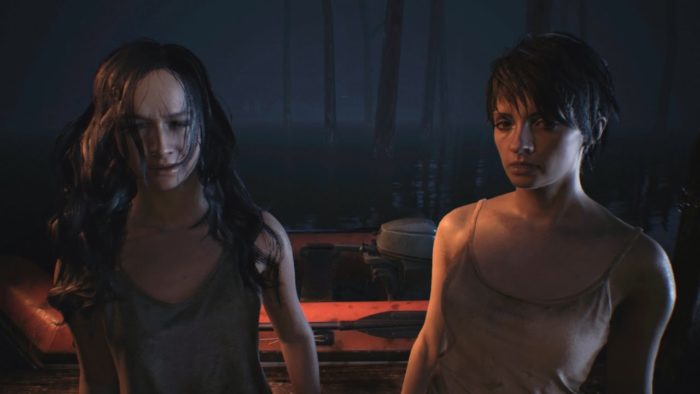
Redfield is the only familiar face present in Resident Evil 7, and he even gets his own DLC called “Not A Hero.” Not A Hero takes place shortly after the events of the main game, with Chris investigating the mines in pursuit of Lucas, who escaped the main game and has kidnapped some of Umbrella’s team. Three important things you need to know about the DLC: it takes place in the same environment as the Ethan section of the final portion of the game, it keeps up the same, more action-oriented tone as that section of the game, and it was originally meant to launch in spring of 2017 but had to be delayed “indefinitely.”
So, based on what little information we have, here’s what I think happened: Resident Evil 7, as it was originally designed by the creative team, was meant to end once you left the Baker mansion. At some point very late into production, likely after it had already been finished or was very close to being finished, someone at a higher-up level that the development team reported to decided that the game was too short, resulting in the dev team having to pad the game at the last minute with content that was originally intended to be DLCs: a Mia centered DLC that never materialized, and what was originally going to be Not A Hero that wound up having to be reworked, resulting in the “indefinite delay” of said DLC. The two collections of non-story DLC are even called Banned Footage Volumes 1 and 2—seemingly perfect to include a DLC that would have included “the truth behind what happened.”
But, apart from the absolutely fumbled ending, Resident Evil 7 is a game that I can’t really think of anything that could be improved upon for what will likely be an inevitable remaster at some point in the future. Maybe some slightly higher resolution textures and real-time ray-tracing, but those are complaints that are relatively small potatoes and beyond that, all I can think of is my likely unrealistic request of “end the game at the mansion as it feels like was the intent.”
But the core of the game—the environment, the characters, the constant loop of “scary thing, escape, and, haha, even scarier thing”—is one that I don’t think has been matched by any other game, either before or afterward. Even Resident Evil Village, for as much as I loved that game, wasn’t as frightening or as tightly constructed and felt more like Resident Evil 4 wearing Resident Evil 7‘s skin than a proper blend of the two, and I’m wondering what the upcoming Resident Evil 9 is going to look like. But until then, here’s to Ethan Winters, the Bakers, a little house of horrors in Louisiana, and the closest thing to a perfect survival horror game we’re likely to ever see.



